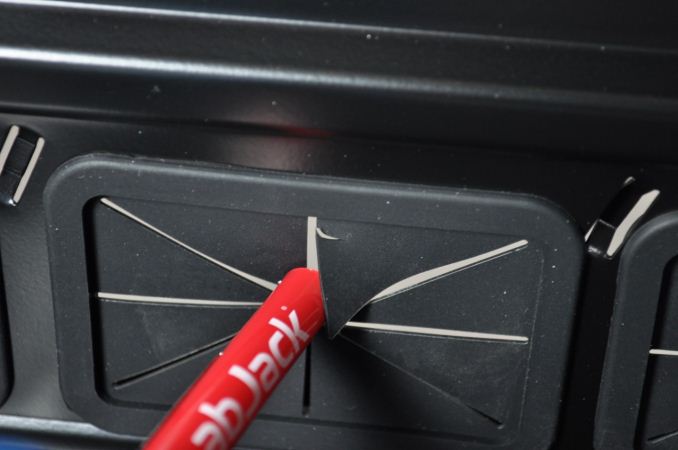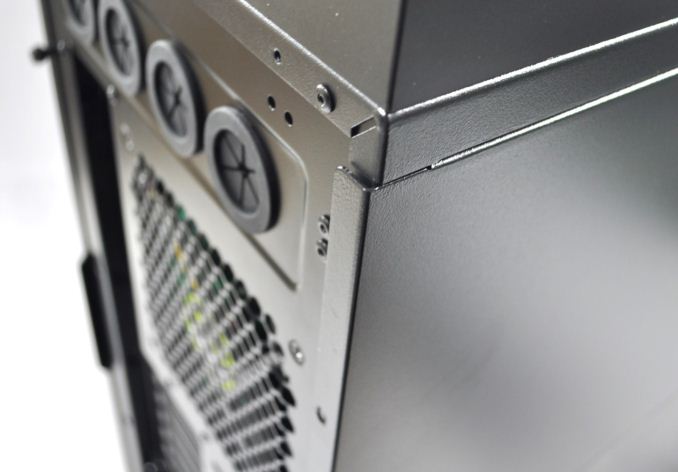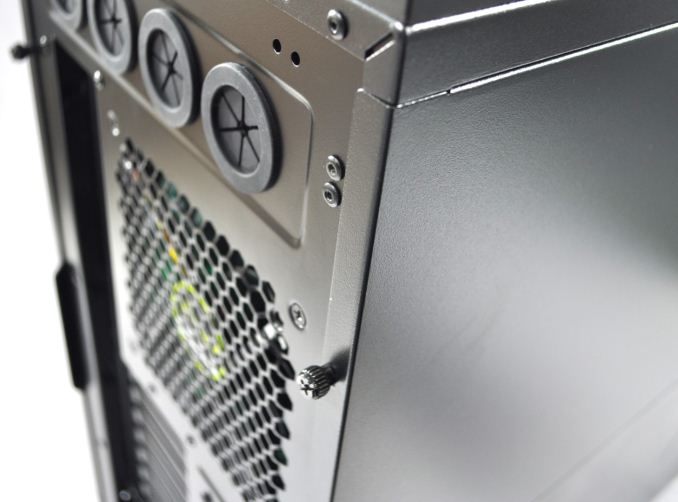Nanoxia Deep Silence 6 Review
by E. Fylladitakis on February 13, 2014 3:00 PM EST- Posted in
- Cases/Cooling/PSUs
- Full-Tower
- HPTX
- Nanoxia
- Case
With the Deep Silence 6, Nanoxia attempted to super-size their first design, the Deep Silence 1,turning it into a spacious, high performance behemoth. The end result is certainly very good, with the high quality a user would expect from Nanoxia and excellent thermal performance. As for space, the Deep Silence 6 has it in spades. Dual CPU and multi-GFX systems will easily fit inside this case, as will multiple liquid-cooling radiators. If desired, it would be possible to fit as many as five 1 × 140mm radiator liquid coolers in the Deep Silence 6 (one at the rear, two at the top, one at the front and one at the bottom of the case), enough for a dual CPU/triple GFX system.
Aesthetics are a subjective factor; while some (including the author) will love the clean, refined design of the Nanoxia Deep Silence 6, others will criticize it and most likely compare the appearnace with that of a refrigerator. Still, we would not go as far as to describe the design as "classic", as Nanoxia does. In fact, the organized lines and clean surfaces of the Deep Silence 6 are the very definition of a "minimalistic" design. A "classic design" and a "design classic" are two entirely different things and Nanoxia is most likely aiming for the latter. The only diminishing factor, if you purchase the version with the side panel window that is, is the second motherboard tray opening, which definitely is functional for users with dual CPU motherboards but will leave a large opening next to any ATX or smaller motherboard.
As with every product ever made, the Nanoxia Deep Silence 6 is not perfect. The most obvious flaw with this case is the massive weight, which will likely result in many of its users looking for gym registrations. Even when empty, the case is almost impossible to handle by anyone without some upper body strength. A set of wheels to replace the feet of the case would be more than a welcome addition, or even selling these as an optional extra. A second minor complaint would be the quality of the rubber grommets around the motherboard tray; they did feel flimsy, so we decided to stress test one by forcefully moving back and forth a bunch of cables through the hole. Soon afterwards, it started cracking. The vast majority of users will never notice such a problem but those who frequently upgrade their systems (or are clumsy at doing so) are likely to end up with a damaged grommet or two.
Super-sizing an existing design can also have significant side effects on the mechanical cohesion of, well, everything. The Deep Silence 6 is no exception; the chassis of the case is exceptionally sturdy and this is why the case is so heavy as well, yet this approach backfires because this chassis bases its structural integrity solely on the metallic frame and the side panels, without any serious support between the four main exterior panels of the chassis. While this probably worked fine with their smaller designs, elongating all of the main panels and doubling the weight of the case weakens the mechanical strength of the design significantly.
As a result, once the side panels are removed, the (empty) chassis frame twists by quite a few minutes, perhaps even over a degree, on its own. This is apparent when installing/removing the side panels, which will not align with the main body of the case until they're screwed in tightly. This is far from a major problem, and the Deep Silence 6 is certainly strong enough to withstand a lot of punishment, yet it is easily noticeable and gives the feeling of a bad mechanical design. On the other hand, extra supports would not only reduce the interior functionality of the case but would probably restrict certain features, such as the front liquid cooling radiator bracket, and they would also increase the weight of an already ridiculously heavy case even further.
Overall, Nanoxia did a great job with the Deep Silence 6, even though it is essentially is a super-sized Deep Silence 1 with added features. It is well made, the design is attractive, it is ludicrously spacious, and it's very versatile. Priced at 199 EUR and currently available for $230 USD or in white for the same price -- though neither option is widely available in the US at present — the Deep Silence 6 is rather competitively priced, steering clear of the price range of other monstrous contraptions like the Corsair 900D and the Cooler Master Cosmos II.
Still, a case of such size and pricing is far from mainstream and has a very specific target audience, which is small and often very demanding. If you're part of that target audience, the DS6 may be precisely what you're looking for. The DS6 does well, and while it's not a clear winner in every respect it also manages to avoid having any serious flaws. If you have the desire (and the requisite muscles) for this sort of case, it's certainly worth a look.













26 Comments
View All Comments
tim851 - Thursday, February 13, 2014 - link
Besides not having any effect on temps, exhausting out the top is bad for noise (in most situations). A case built to be silent should never have top vents.vshah - Thursday, February 13, 2014 - link
One thing missing from the new case review format is pictures of an actual complete install in the case. This was crucial in seeing how cables etc. could be routed with all components in place.E.Fyll - Friday, February 14, 2014 - link
Actually, I skipped such an endeavor thinking that it could be deceiving, as it could appear a lot more messy than it could have become after some care and consideration when routing the cables. On the other hand however, I reconsidered and now think that it would be a good idea to show just how messy things can become. I will plan on adding such info in my future articles.tim851 - Thursday, February 13, 2014 - link
A silent PC was a challenge in 2005 or so. You had to mad, tinker, experiment.Nowadays CPUs and GPUs idle in single watts, good PSUs are semi-passive and half a terabyte of solid state storage are affordable.
Jeffrey Bosboom - Thursday, February 13, 2014 - link
When taking exterior case shots, please include another object so we can get a sense of scale.Sushisamurai - Friday, February 14, 2014 - link
I vote for a coke canredmist77 - Friday, February 14, 2014 - link
Great suggestion!E.Fyll - Friday, February 14, 2014 - link
That sounds like a good idea. Coke can it is, I suppose. Its size is universal. :)Slash3 - Friday, February 14, 2014 - link
Everyone knows that the standard measurement of scale is a banana...http://knowyourmeme.com/memes/banana-for-scale
c4v3man - Thursday, February 13, 2014 - link
I have a Deep Silence 2 case, and while it's a decent case, it's not perfect. On the Deep Silence 2 at least, the air chimney at the top stays open well enough, but I would prefer a reassuring "click" at the top. The hard drive bays (of which there are many) are designed in such a way that they block a lot of airflow... I would prefer a more skeleton-ized design, to let the air move through. And finally, while the doors have a satisfying heft to them, they use a latching system similar to cheap cases today, and of a decade ago. When spending this much of a case, I want the doors to go on with zero hassle. They're not the worst I've ever used, but certainly not the best design.